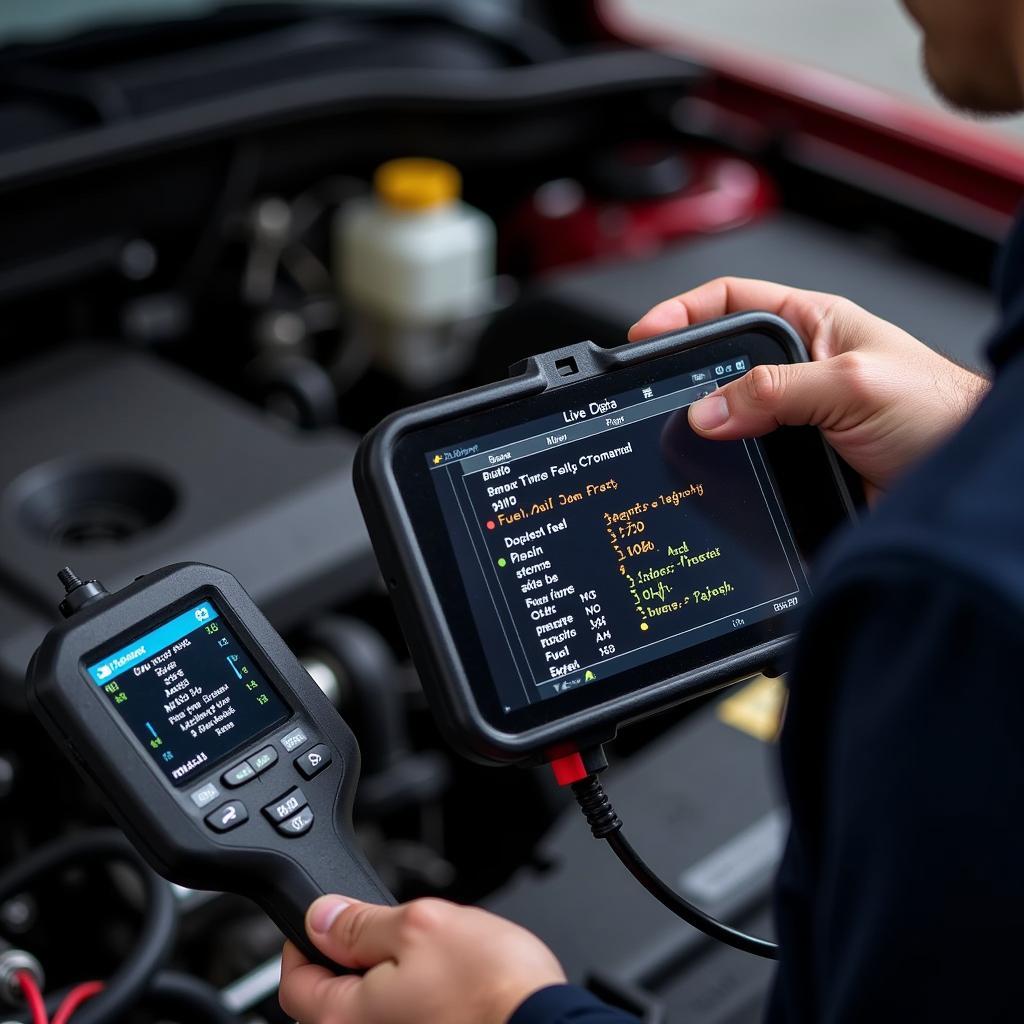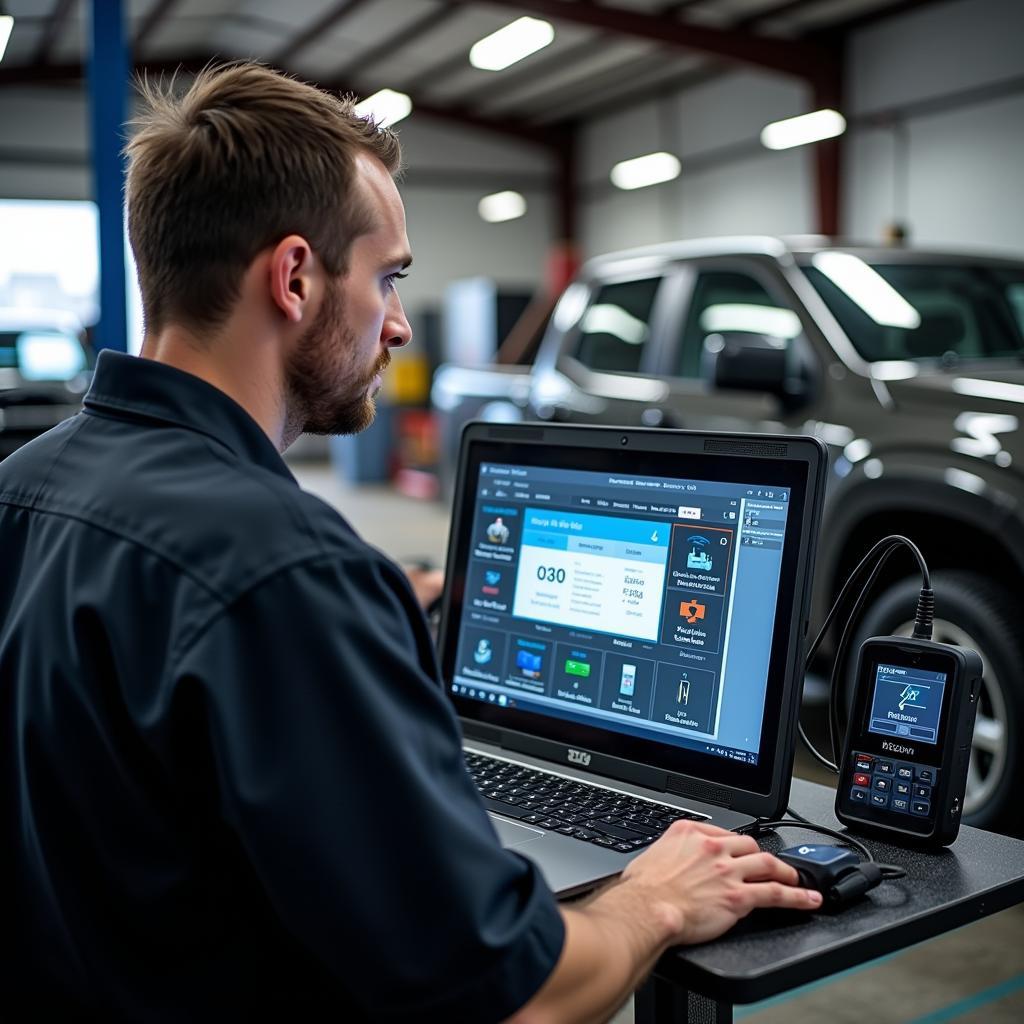Checking fuel pressure is crucial for diagnosing engine performance issues. While a mechanical fuel pressure gauge remains the most accurate method, a scan tool can offer valuable insights, sometimes even allowing you to check fuel pressure indirectly. This article will guide you on how to utilize a scan tool for this purpose and what other information it can provide to pinpoint fuel-related problems.
A scan tool, or more specifically, an electronic scanner to enter a car, can provide a wealth of information beyond just reading trouble codes. By accessing live data parameters, you can gain a comprehensive understanding of your vehicle’s fuel system performance.
Understanding Fuel Pressure Data with a Scan Tool
Not all vehicles allow direct fuel pressure readings via a scan tool. However, even without a direct reading, you can deduce a lot about fuel pressure by examining related parameters. These include fuel rail pressure sensor readings, fuel pump duty cycle, injector pulse width, and short and long term fuel trims.
Inferring Fuel Pressure from Related Data
- Fuel Rail Pressure Sensor: If your vehicle is equipped with a fuel rail pressure sensor, this is your best bet. The scan tool will display the actual pressure in the fuel rail, giving you a close approximation of fuel pressure at the injectors. Low readings here point towards a fuel delivery problem.
- Fuel Pump Duty Cycle: This parameter indicates how hard the fuel pump is working. A consistently high duty cycle, especially under low engine load, suggests the pump is struggling to maintain pressure, possibly due to a failing pump, clogged filter, or restricted fuel lines.
- Injector Pulse Width: The length of time the injectors stay open is directly related to fuel delivery. Longer pulse widths could indicate low fuel pressure, as the engine control module (ECM) attempts to compensate by injecting more fuel.
- Fuel Trims: Both short and long term fuel trims show how the ECM is adjusting fuel delivery to maintain the ideal air-fuel ratio. Positive fuel trims mean the ECM is adding fuel, which could be a sign of low fuel pressure.
 Checking Fuel Pressure with a Scan Tool
Checking Fuel Pressure with a Scan Tool
Diagnosing Fuel System Problems Using a Scan Tool
Besides simply checking fuel pressure-related data, you can use automotive scan tools service functions to perform active tests and pinpoint the source of a problem. For example, some scan tools allow you to command the fuel pump on and off, helping you isolate a faulty pump or relay.
Active Tests and Troubleshooting
- Fuel Pump Activation Test: If you suspect a weak fuel pump, an activation test can confirm your suspicions. By commanding the pump on with the scan tool, you can listen for the characteristic whirring sound and observe the changes in live data.
- Monitoring Fuel Trims During a Test Drive: Observing fuel trims while driving under different load conditions can reveal intermittent fuel delivery problems that might not be apparent at idle.
- Checking for Diagnostic Trouble Codes (DTCs): While not a direct measure of fuel pressure, DTCs related to the fuel system, such as lean codes, can indicate a pressure issue. Your scan tool will retrieve these codes and guide you towards a diagnosis.
“When diagnosing fuel-related issues, remember to consider all available data. Don’t just focus on one parameter. Correlating different data points paints a more complete picture,” advises John Smith, a seasoned automotive electrical engineer at ScanToolUS.
Limitations of Using a Scan Tool for Fuel Pressure
While a scan tool offers valuable insights, it’s important to acknowledge its limitations. It doesn’t always provide direct fuel pressure readings, and the available parameters can vary significantly between vehicle makes and models. Sometimes, a mechanical gauge remains the most reliable option.
When a Mechanical Gauge is Necessary
- No Fuel Pressure Sensor: Older vehicles or those without a fuel rail pressure sensor require a mechanical gauge for direct measurement.
- Inconsistent Data: If the scan tool data seems erratic or unreliable, a mechanical gauge can provide a more accurate reading.
- Pinpointing Specific Problems: While a scan tool can narrow down the possibilities, a mechanical gauge is sometimes essential for confirming a diagnosis, such as a restricted fuel line.
“A scan tool is a powerful diagnostic tool, but it’s not a magic bullet. Knowing its limitations and when to use a mechanical gauge is essential for effective troubleshooting,” adds Maria Garcia, Senior Automotive Technician at a leading repair shop.
You can gather a lot of information using car scanner live data, even for specific models like described in our article about 2015 sierra duramax cel codes without scan tool. Even if you’re working on a scan tool for bikes, the principles of analyzing live data remain the same.
Conclusion
Checking for fuel pressure with a scan tool offers a convenient and insightful way to diagnose fuel-related problems. While not always providing a direct reading, analyzing related parameters like fuel rail pressure, fuel pump duty cycle, and fuel trims can help pinpoint the source of the issue. However, remembering the limitations of a scan tool and knowing when a mechanical gauge is necessary is crucial for efficient and accurate troubleshooting. Contact ScanToolUS at +1 (641) 206-8880 or visit our office at 1615 S Laramie Ave, Cicero, IL 60804, USA for further assistance and expert advice.


